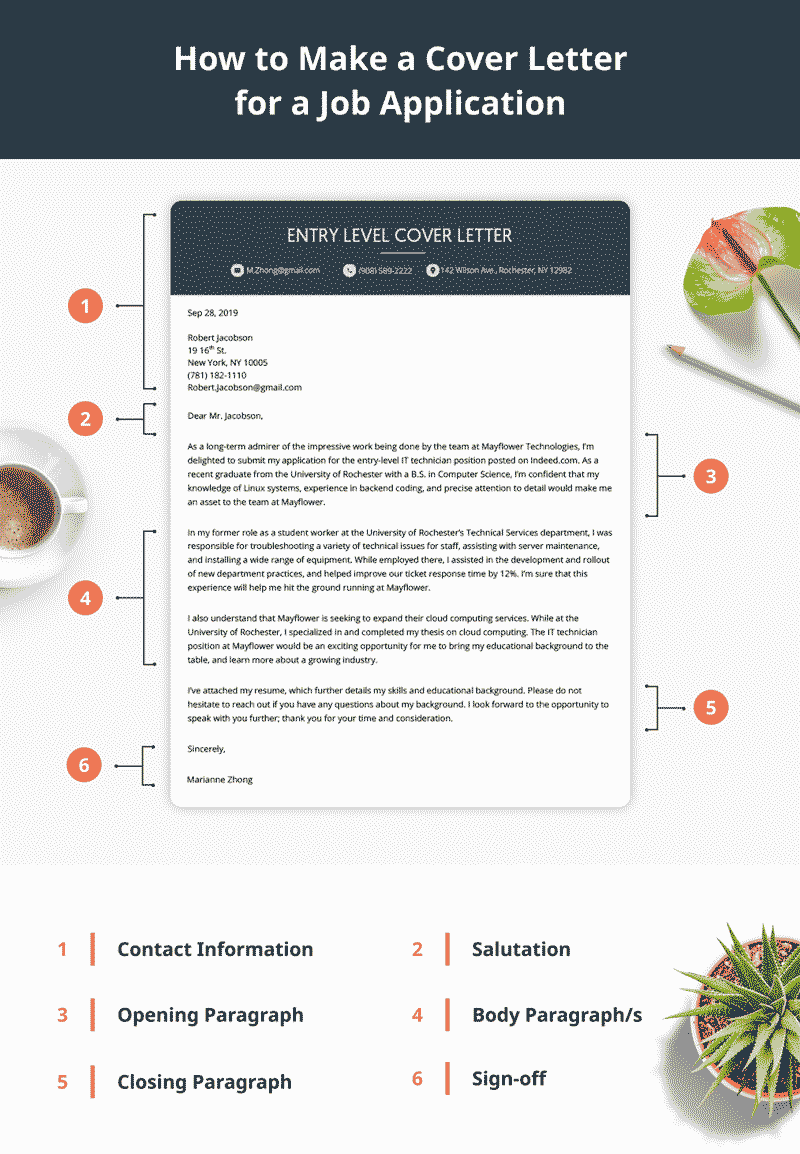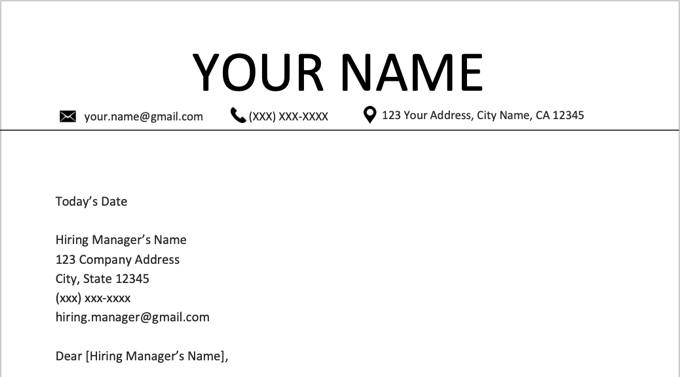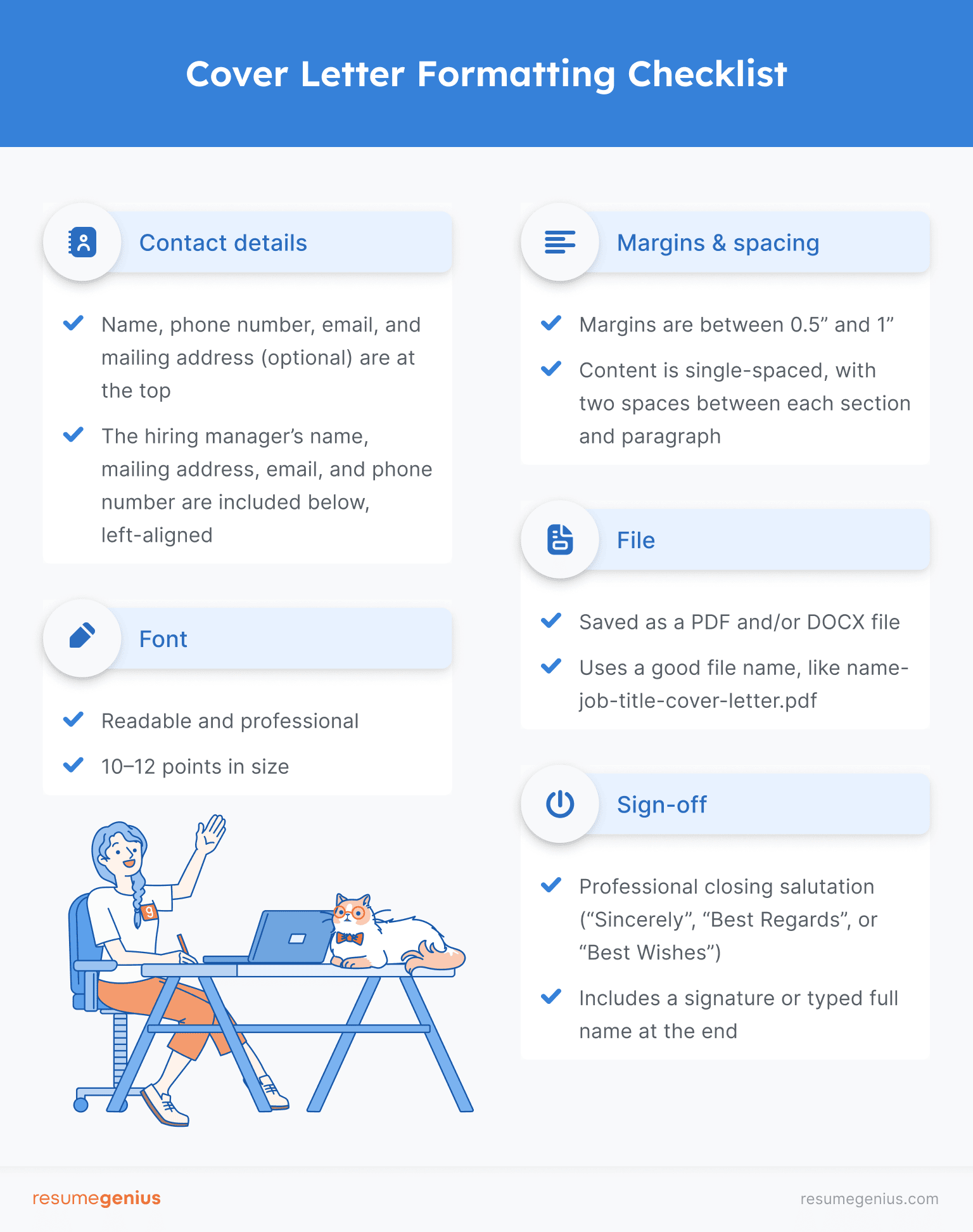The Biggest Error Most Applicants Make When Writing A Cover Message Is
Before we walk you through how to write a cover letter and showcase our many cover letter resources, it's good to first understand what a cover letter is exactly, and why you need one for your job application.
What is a cover letter?
A cover letter is a one-page document that introduces a job seeker's work history, professional skills, and personal interest in applying for a job.
The main purpose of a cover letter is to support the content of your resume. Your resume focuses on your qualifications and achievements, and your cover letter expands on those achievements, showcases your personality, and explains why you'd be a good fit for the company.
Although they might seem old-fashioned today, cover letters are still necessary. High unemployment rates in 2020 created a bigger pool of job seekers in 2021, and writing a cover letter helps your application stand out when applying for competitive positions.
Attach an effective cover letter to your well-written resume, and your job application will quickly show managers and recruiters you're both qualified and a great fit for the role.

What to include in your cover letter
When you begin writing, use the following structure (and feel free to copy-paste this information into your favorite cover letter template):
YOUR NAME
[Your phone number] [Your email address] [Your mailing address / LinkedIn profile /portfolio / website (optional)]
[Hiring manager's name]
[Company address]
[Company phone number]
[Hiring manager's email address]
Dear [Mr./Ms./Mx.] [Hiring manager's name],
Opening paragraph that mentions your years of relevant experience, how you found out about the job, and why you're interested in the position. Make sure you use the correct job title here, or else the employer will think you're sending out a generic cover letter.
Body paragraph(s) that provide examples of your professional accomplishments, skills, and work experience. These examples should all tie into why you're the best fit for the role.
- You can include bullet points in this section to highlight your greatest relevant achievements
- Using numbers to outline these achievements makes their significance more apparent to the hiring manager
Closing paragraph that expresses your interest (again), and restates why you're the right candidate for the job. You can mention whether you prefer to be contacted by phone or email here as well. If you prefer phone calls, provide some times when you're available.
[Sincerely / Best / Best regards],
[Your name]
How to write a cover letter that gets you the job
From top to bottom, here's how to make a cover letter in six steps:
- Write out your contact information (and the employer's details)
- Address the hiring manager (ideally by their name)
- Put together a clear, targeted opening paragraph
- Write informative, relevant body paragraphs
- Finish with a concise, direct closing paragraph
- Sign off ("Sincerely," and your name below)
1. Write out your contact information (and the employer's details)
Underneath your name in your cover letter header, write your contact details:
- First and last name
- Email address (something professional, usually including your name)
- Phone number
- Mailing address (optional)
- Linkedin profile link (optional)
- Portfolio or website (optional)
Below your contact details and left-aligned, include the date and the company's contact information, such as the:
- First and last name of the person you're writing to, or the relevant department
- Company address
- Company phone number
- Hiring manager's email address
Here's an example of how contact details are formatted on a professional cover letter:

2. Address the hiring manager (ideally by their name)
If you can address your cover letter to the reader using their name, do it.
Greetings like "To Whom It May Concern" and "Dear Sir or Madam" are old-fashioned, plus it's easier than ever to find the right person's name using LinkedIn, exploring a company's website, or contacting their human resources department and asking.
Here are some cover letter salutation suggestions if you're struggling to find the right information:
- If you're not certain about the recruiter's title (like Mr., Mrs., Ms., Dr., etc.,) you can leave it out. For instance, "Dear Jane Smith" is acceptable.
- If you can't figure out who the recruiter is, guess. For example, if you're applying for a marketing position, address the marketing director by name instead.
- If you can't find anyone's name, address your cover letter to the department. For instance, "Dear Marketing Department" is okay.
Opening salutation examples
- Dear Jane Smith
- Dear Ms. Smith
- Dear Accounting Department
- Dear [Company Name] Recruiter
3. Put together a clear, targeted opening paragraph
Start your cover letter with an informative, direct introduction by including the following details in the first one or two sentences:
- Job position: The title of the advertised position
- Company name: The name of the company looking to hire
- How you discovered the opening: Whether you saw the job on LinkedIn, a job board, or were recommended to apply by a friend
- Intention to apply: An enthusiastic announcement that you're applying for the open role
Including these four pieces of information makes it clear you're a serious applicant — one who isn't simply sending out a generic cover letter and hoping for a response.
Here's an example of a cover letter opening paragraph that effectively introduces the applicant:

You can also make your introduction even more attention-grabbing by adding a bit of personality, passion, or including a major career highlight. Don't be afraid to let some of your unique personality shine through in your cover letter.
Just be sure to strike the right tone for your industry or field. For instance, if you're applying for a job in law, keep your writing formal.
Here are some examples of unique cover letter openings you can try:
Express your love for the company
It's been a lifelong dream of mine to become a character designer for Disney, which is why I'm so excited to apply for this open position.
Highlight a past achievement
I'm a believer that small details make a big difference, and I made my last boss a believer too after saving the company $60,000 in 2020 by simply analyzing and questioning each line on an enormous balance sheet. If Trulane Accounting is seeking an accountant who won't skip over the small stuff, I believe I'm the perfect candidate for this job.
Express passion for your work
I'm excited to be applying for the social media position at Luxe Fashion. I'm what people now call an Extremely Online person, which is why I've been so successful at driving traffic and interest to my last company's social media feeds — and I'd love to do the same for your brand.
4. Write informative, relevant body paragraphs
Next, it's time to make a convincing argument you're the right person for the job by discussing your experiences, skills, and achievements that are relevant to the position.
In one or two paragraphs plus bullet points (if you have some particularly impressive accomplishments to highlight), show the reader that you easily fit the needs outlined in the job description.
For job seekers with work experience
Hiring managers will look closely at your cover letter for evidence that you're qualified and worth considering for the position. Use your recent work history and achievements to prove (with numbers) that you have the skills to get the job done.
Here are some things to include in your cover letter that highlight your value to an employer:
- Professional achievements : Did you exceed targets for production, sales, revenue, profit, customer satisfaction, or any other business objectives?
- Professional praise : Have you received compliments from management or colleagues for your work?
- Professional awards: Have you received awards for your work, like Employee of the Month?
In the following examples, we've color-coded the achievements, praise, and awards with underlining to show you how to include each:
Body paragraph example (experience)
I've been praised by management for consistently executing email marketing campaigns that perform 20% higher than baseline. In 2019, I was awarded Employee of the Year for my efforts. With my skill set, I'd be a strong asset at Westward Strategies, and significantly contribute to the team's success.
Body paragraph, achievements-focused (experience)
Duties at my previous company included making 60 cold calls a day to businesses and private individuals in order to solicit sales for goods and services. During my tenure, I implemented a new mobile strategy, reducing training expenses by 90% and increasing the close ratio by 10% on telephone sales within 3 months.
For job seekers without much work experience
If you lack professional experience, writing a cover letter can seem difficult. Fortunately, employers understand that many applicants (especially for entry-level positions) don't have much experience. So instead, they will judge your cover letter based on other qualities, such as:
- Academic (and other) achievements : Do you have a degree (bachelor's, master's, or Ph.D.)? Is your GPA above 3.5, and did you receive awards like cum laude, magna cum laude, or summa cum laude? Did you land a scholarship? Did you complete a thesis?
- Extracurricular activities : Have you done any part-time work, or been involved in volunteering, student government, clubs, athletics, theater, or other activities? Do you have hobbies and interests related to the job?
- Self-motivation and goal setting : What are your short- and long-term goals, and how does the job you're applying for fit in with them?
Just remember that any of the information you include should be relevant to the role. For instance, your theater club experience shouldn't be brought up in your cover letter for an accounting job, unless you were the treasurer.
The employer may also be evaluating your application based on the quality of your writing, so it's even more important to take your time when writing an entry-level cover letter.
We've color-coded the following examples to demonstrate how you can write your cover letter in a way that best emphasizes your relevant educational and personal details:
Body paragraph example (no experience)
I recently graduated summa cum laude (3.7 GPA) with a BS in Accounting from the University of Maryland. During my final two years there, I served as treasurer for the Student Government Committee, managing a $30,000 budget, developing internal controls and financial management policies, and providing accurate financial reporting. I'm excited to bring a significant amount of real-world experience to your entry-level role, and quickly prove my worth.
5. Finish with a concise, direct closing paragraph
When writing your cover letter closing, be polite, confident, and continue to sell yourself as the best candidate for the job. It's important to write your final paragraph thoughtfully and strategically, so be sure to:
- Thank the hiring manager for reviewing your application
- Summarize why you'd be a good hire
- Restate your excitement about the job opportunity
- Politely ask the reader to send you an invitation to interview
Here's an excellent cover letter closing example:

6. Sign-off ("Sincerely," and your name below)
Wrap up your cover letter with a professional closing salutation:
7 cover letter sign-offs to use
- Sincerely
- Best
- Regards
- Thank you
- Respectfully
- Kind regards
- Best regards
Finally, make two spaces between the salutation, and type your full name.
Reviewing your cover letter
Before you send off your newly written cover letter, you should review it. Here are a few extra things to consider to make sure your application is perfect when you send it out:
Cover letter formatting
A professional cover letter is normally 200–350 words, single-spaced, and uses either US Letter (USA) or A4 (Europe and elsewhere) page size. It should be typed with a standard cover letter font like Arial or Calibri, and the font size should be between 10.5 and 12 points.
Additionally, your cover letter margins should be between 1″ and .5″ on each side to make sure it's easy to read. And all of the content should be left-aligned except for your own contact details, which can be centered.
Your cover letter's format won't win you the job, but it can lose you the job if done haphazardly.

Your writing tone
A classic cover letter writing mistake is to write long sentences with overly formal wording. Unless the job calls for it, aim for clear and easy-to-understand writing to make your text as readable as possible.
To instantly improve your writing tone, try:
- Using contractions, like "don't" instead of "do not"
- Avoiding clichéd words and phrases, like "dynamic," "thinking outside the box," and "synergy"
- Choosing simpler forms of words, like "helpful" instead of "advantageous"
Here's a comparison between a personable writing style and an overly formal one:
Excited and professional
I'm thrilled to apply for the customer service position at [Company Name]. Having been a customer service representative for 5+ years at Walmart, I'm confident I can quickly apply my experience using Zendesk and Salesforce to make a positive impact on [Company Name]'s bottom line.
Too formal
It is with great interest that I apply for the open customer service position posted by your company on Indeed. I possess the requisite skill set to ably perform the customer service duties described in the job requirements.
Details you shouldn't include in your cover letter
The following information makes your cover letter unprofessional, and may even invite discrimination from your potential employer. Delete any of the following from any of your application documents:
- Personal information, such as family, religion, sexual orientation, or gender
- Salary information, such as former salary, or salary expectations
- Questions and inquiries, such as ones about company benefits or job expectations. If you need to know, ask in an email outside of your application, or during the interview process.
- Information copy-pasted from your resume, such as bullet point sentences or skills lists. Instead, reference information from your resume in your cover letter naturally, and expand on it.
- Photos, like a professional headshot. If you're a US-based job seeker, headshots are not necessary for the vast majority of jobs.
Proofreading
Worried your cover letter might have a typo or grammar error? Here are two quick tricks professional editors use to catch sneaky mistakes and make good edits:
- Read your writing out loud: Doing this will force you to consider every word, sentence, paragraph, and punctuation mark. Plus you'll catch hard-to-read sentences, and can then adjust them as necessary.
- Change the font: A new font forces your brain to grapple with something that seems new. Switching your cover letter to a different font can help you notice mistakes you'd otherwise skim over and miss.
After you've read your cover letter out loud, have someone else read it out loud too. They can provide helpful feedback like whether your letter is clear and well-argued, or vague and filled with cliches. They'll also notice small grammar and spelling errors you missed.
Cover letter resources
Here are some of our best cover letter guides and resources from across the website:
- Templates
- How-to guides
- Types of cover letters
- By industry
- FAQs
Cover letter templates
Over one million people have downloaded these three cover letter templates. Each one has a matching resume template.
Additional cover letter templates
- Basic and simple templates
- Professional templates
- Modern templates
- Google docs templates
Cover letter writing how-to guides
Looking for more help on how to make a cover letter's different sections really shine? Try these four writing guides:
- How to start a cover letter
- How to end a cover letter
- How to address a cover letter
- How to sign a cover letter
Types of cover letters
Cover letters are used in many situations. Create yours by getting ideas from examples that apply to your specific background and career goals:
- High-school student
- College student
- Recent graduate
- Internship
- Research assistant
- Entry-level
- For a career change
- For an internal position
- Short cover letter examples
- Relocation
- Non-profit
Cover letter examples from different industries
Here are our top 10 most popular cover letter samples as voted on by our users. Each sample has a corresponding resume example.
- Accounting
- Administrative assistant
- Customer service representative
- Engineering
- Human resources (HR)
- Information technology (IT)
- Nursing
- Data analyst
- Teacher
Cover Letter Writing FAQs
And finally, here are some of our most notable cover letter FAQs (in case you're still looking for answers to your cover letter-related questions):
- How do I include a referral in a cover letter?
- How do you write salary requirements in a cover letter?
- What is an enclosure in a cover letter?
- Should you use a template for a cover letter?
- Does a CV include a cover letter?
- Can a cover letter be two pages?
- Do cover letters need an address?
- Do I need to sign a cover letter submitted electronically?
- How do I include a referral in a cover letter?
- Should you put a photo on a cover letter?
The Biggest Error Most Applicants Make When Writing A Cover Message Is
Source: https://resumegenius.com/blog/cover-letter-help/how-to-write-a-cover-letter
Posted by: hallwhats1993.blogspot.com

0 Response to "The Biggest Error Most Applicants Make When Writing A Cover Message Is"
Post a Comment